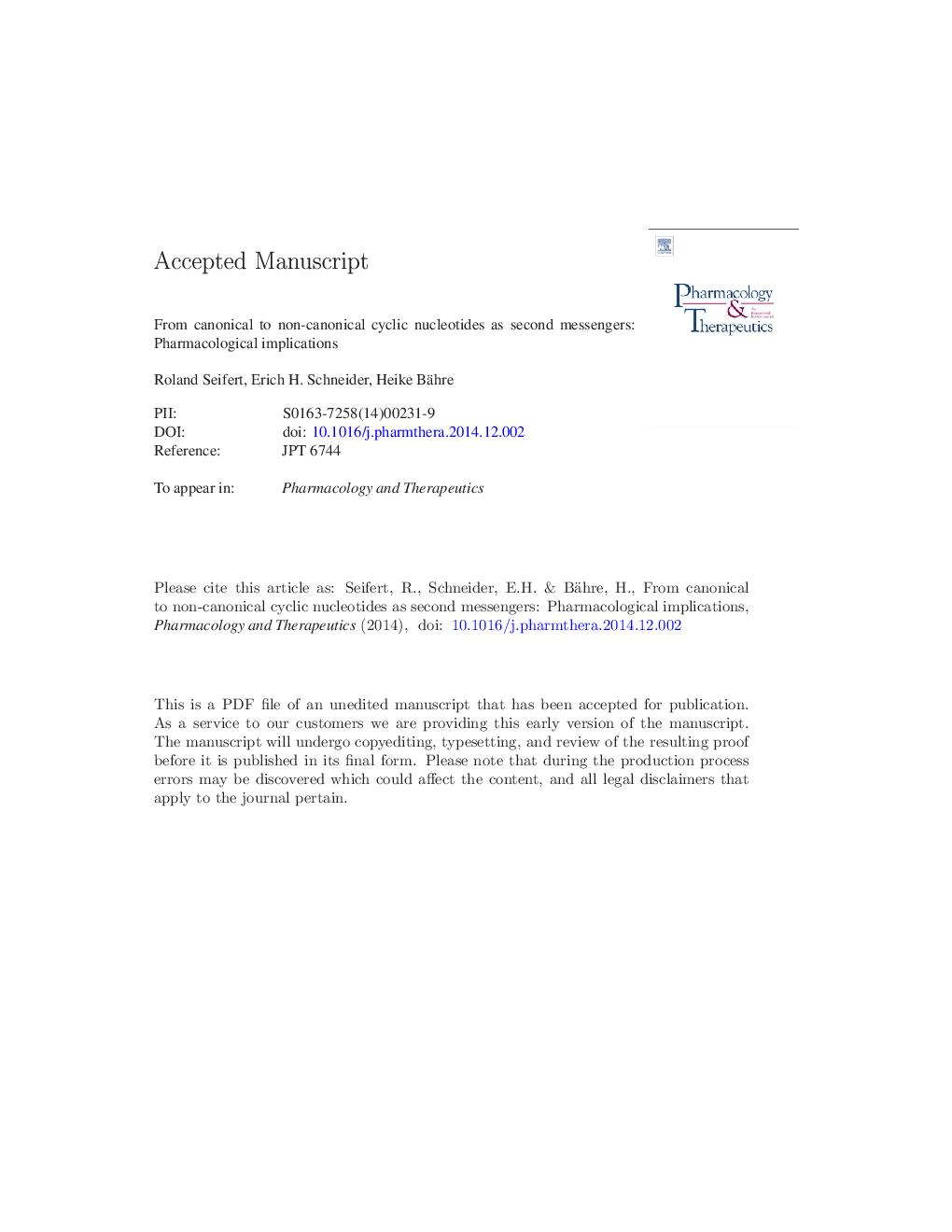| کد مقاله | کد نشریه | سال انتشار | مقاله انگلیسی | نسخه تمام متن |
|---|---|---|---|---|
| 5843979 | 1560957 | 2015 | 81 صفحه PDF | دانلود رایگان |
عنوان انگلیسی مقاله ISI
From canonical to non-canonical cyclic nucleotides as second messengers: Pharmacological implications
ترجمه فارسی عنوان
از نوکلئوتید های چرخه ی کانونیک به غیر کانونی به عنوان پیام دوم: اثرات فارماکولوژیک
دانلود مقاله + سفارش ترجمه
دانلود مقاله ISI انگلیسی
رایگان برای ایرانیان
کلمات کلیدی
IBMXcNMPPGCcCMPCIMPExoYCyaACTMPSGCinosine 3′,5′-cyclic monophosphatePKGnucleoside 3′,5′-cyclic monophosphateuridine 3′,5′-cyclic monophosphateMRPGPCRpKaLLOQANPSACDMRcGMPPDEcAMP - cAMPG-protein-coupled receptor - G-پروتئین گیرندهHPLC-MS/MS - HPLC-MS / MSadenosine 3′,5′-cyclic monophosphate - آدنوزین 3 '، 5'-سیکلیک منوفسفرهadenylyl cyclase - آدنیلات سیکلاز، آدنیلیل سیکلازisobutylmethylxanthine - ایزوبویل methylxanthinecUMP - تعادلBacterial toxins - توکسینهای باکتریاییOat - جو دو سرSoluble guanylyl cyclase - حلال گویینیل سیکلاسorganic anion transporter - حمل کننده آنیون آلیparticulate guanylyl cyclase - ذرات گویینیل سیکلاسcytidine 3′,5′-cyclic monophosphate - سیتیدین 3 '، 5'-سیکل مونوفسفرهHigh performance liquid chromatography tandem mass spectrometry - طیف سنجی جرمی کروماتوگرافی با عملکرد بالاPhosphodiesterase - فسفو دی استرازPhosphodiesterases - فسفودی استرازlower limit of quantitation - محدودیت پایین کمیتMAC - مکprotein kinases - پروتئین کینازcAMP-dependent protein kinase - پروتئین کیناز وابسته به cAMPcGMP-dependent protein kinase - پروتئین کیناز وابسته به cGMPatrial natriuretic peptide - پپتید نایروئیدوری دهلیزSecond messengers - پیامبر دومHCN channels - کانال های HCN
موضوعات مرتبط
علوم پزشکی و سلامت
داروسازی، سم شناسی و علوم دارویی
داروشناسی
چکیده انگلیسی
This review summarizes our knowledge on the non-canonical cyclic nucleotides cCMP, cUMP, cIMP, cXMP and cTMP. We place the field into a historic context and discuss unresolved questions and future directions of research. We discuss the implications of non-canonical cyclic nucleotides for experimental and clinical pharmacology, focusing on bacterial infections, cardiovascular and neuropsychiatric disorders and reproduction medicine. The canonical cyclic purine nucleotides cAMP and cGMP fulfill the criteria of second messengers. (i) cAMP and cGMP are synthesized by specific generators, i.e. adenylyl and guanylyl cyclases, respectively. (ii) cAMP and cGMP activate specific effector proteins, e.g. protein kinases. (iii) cAMP and cGMP exert specific biological effects. (iv) The biological effects of cAMP and cGMP are terminated by phosphodiesterases and export. The effects of cAMP and cGMP are mimicked by (v) membrane-permeable cyclic nucleotide analogs and (vi) bacterial toxins. For decades, the existence and relevance of cCMP and cUMP have been controversial. Modern mass-spectrometric methods have unequivocally demonstrated the existence of cCMP and cUMP in mammalian cells. For both, cCMP and cUMP, the criteria for second messenger molecules are now fulfilled as well. There are specific patterns by which nucleotidyl cyclases generate cNMPs and how they are degraded and exported, resulting in unique cNMP signatures in biological systems. cNMP signaling systems, specifically at the level of soluble guanylyl cyclase, soluble adenylyl cyclase and ExoY from Pseudomonas aeruginosa are more promiscuous than previously appreciated. cUMP and cCMP are evolutionary new molecules, probably reflecting an adaption to signaling requirements in higher organisms.
ناشر
Database: Elsevier - ScienceDirect (ساینس دایرکت)
Journal: Pharmacology & Therapeutics - Volume 148, April 2015, Pages 154-184
Journal: Pharmacology & Therapeutics - Volume 148, April 2015, Pages 154-184
نویسندگان
Roland Seifert, Erich H. Schneider, Heike Bähre,
